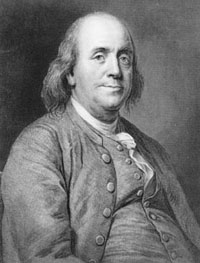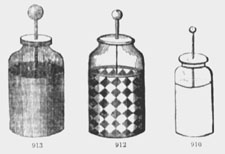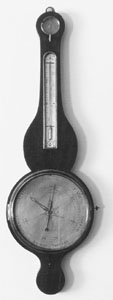 |
|
|
|
WHEN SCIENCE, ART, AND FUN WERE ONE
Benjamin Franklin and ‘Science in the American Parlor’
(From Fall 2003 21st Century, partial text)
by Elisabeth Pascali
The American Philosophical Society, founded by Benjamin Franklin in 1743, brought the intellectual culture of early America to life with a recent exhibit of the scientific instruments in daily use in Philadelphia, 1750-1875.
What distinguishes an empire from a republic? How is it that the population of the 1700s in the United States was so much more optimistic, willing to solve problems and not settle for a tyranny? What has kept us, so far, from regaining such strength today?
These and other reflections on life in the 1700s came to mind while visiting a fascinating exhibit sponsored by the American Philosophical Society in Philadelphia, in February 2003, titled “From the Laboratory to the Parlor: Scientific Instruments in Philadelphia, 1750-1875.” The exhibit not only gave a glimpse of what life must have been like in the first years of the Republic’s history, but also, through contrast, shed light on the path that our nation has followed since that time.
The American Philosophical Society (APS) was one of several institutions founded and fostered by Benjamin Franklin. In 1743, he circulated a letter, titled “A Proposal for Promoting Useful Knowledge among the British Plantations in America,” which solicited interest in founding a society of correspondence so that members who were separated from each other by great distances could keep current on the latest developments in “natural philosophy,” the term which, in that day, meant any kind of physical scie‰ce as well as mathematics. Over the next several decades, many of the men most responsible for founding the United States—George Washington, John Adams, Thomas Jefferson, Alexander Hamilton, Thomas Paine, and James Madison, among others—became members.
The APS still exists today. Because many of its early members, or their descendants, bequeathed their papers, scientific instruments, natural history collections, and other artifacts to the Society, it has one of the most exciting archives of writings and objects from American society of the 1700s and 1800s. The APS has always made its library available to scholars, but, until now, has kept a relatively low profile in terms of educating the general public. This changed with the decision to hire a curator for the collection, and to sponsor a series of public exhibits. Judging from the first exhibit, Ms. Sue Ann Prince, the new curator, has done an excellent job.
The first exhibit, “From the Laboratory to the Parlor,” unfortunately closed on March 31, 2003, very soon after this author visited it. The exhibit deserves to continue on, for every school-age child, as well as those young at heart, should see it, to catch the spirit of the time, and understand the scientific culture of the early days of this nation. The exhibit takes up only one large room in the APS Philosophical Hall, a room dominated by several telescopes, globes, clocks, and portraits of early APS members. Each nook and cranny tells the story of a lost chapter in the history of the United States.
|
|
|
|
|
|
 |
|
Engraving by H.B. Hall from the original portrait painted from life by J.A. Duplessis in 1783. Courtesy Library of Congress
Benjamin Franklin, founder of the American Philosophical Society (APS), with drawings of early electricity experiments.

|
 |
|
|
|
|
|
|
|
|
The banjo barometer on display at the APS exhibit, which was used to follow changes in the weather.
|
 |
“I think a general government necessary for us, and there is no form of government but what may be a blessing to the people if it is well administered; and believe farther that this is likely to be well administered for a course of years and can only end in despotism, as other forms have done before it, when the people shall become so corrupt as to need despotic government, being incapable of any other. . .”
—Benjamin Franklin to the delegates of the Constitutional Convention, prior to the final vote |
|
|
|
|
|
The American Parlor in the 1800s
The scientific instruments from Benjamin Franklin’s time were used not just by a few intellectuals and scientists in a backroom laboratory, but by everyone, as this exhibit shows. The ferment and excitement over discovering new things with these instruments was clearly so widespread that it was sometimes difficult to distinguish between science, the application of science in the form of new technology, and daily entertainment.
That may be a real shock for today’s audience, when the kindest thing that can be said about today’s popular entertainment is that it tends to encourage the lowering, or “relaxing,” of the level of thinking among the population, rather than uplifting and developing it. The parlors, or living rooms, were much different places in the 18th and 19th Century than they are today. Often the parlors displayed globes, a microscope, or an electrical machine. The most popular parlor activities were those that combined advanced technology with fun. This was one of the central themes of the APS exhibit.
The exhibit displayed an example of a Sun microscope which allowed the magnified image of a specimen to be projected onto a wall for everyone in the room to see. There were several different pocket telescopes, microscopes, sundials, and other instruments used by youngsters and amateur scientists in exploring the world around them. There were also three different catalogs of optical, mathematical, and “philosophical” instruments for the “upscale and every day man” of the mid-1800s. It is easy to picture children (and parents) carrying portable microscopes into the fields, finding interesting specimens to collect, and bringing them back to the parlor for later display and discussion.
The exhibit showed some of the original illustrations of the microscope by a German illustrator of the period, Martin Frobenus Ledermuller. Microscopic life was a subject of great excitement and debate, from scientific laboratories and meeting rooms to the family living room.
At the entrance of the exhibit, it was hard to miss two large globes on stands: one terrestrial (of the Earth) and one celestial (of the stars). These globes which are beautiful enough to be used as ornaments, could also be used to follow the journals of great contemporary explorers like Captain Cook, as they travelled to new, unknown lands, or to learn how to make astronomical observations. There was also a beautiful Italian-style banjo barometer, which could be used to follow changes in the weather.
Imagine if the entertainment centers of living rooms today had globes to spark the imagination of our children, and Leyden jars (see section on electrical experiments) to spark their fingers in a way to help them rediscover the great electrical discoveries of Benjamin Franklin. In fact, there are many more modern breakthrough experiments which would be relatively easy to recreate as well, such as the electrical experiments of André-Marie Ampère, or Pierre Curie’s piezoelectrometer for detecting radioactivity.
Although not part of this exhibit, music and art were also a big part of parlor life in the 18th Century. Just as professional science was not separated from popular culture, music and art were not divorced from science and everyday life. In his Autobiography, Benjamin Franklin describes his father thus:
. . . he was ingenious, he could draw prettily, was skilled a little in music, and had a clear pleasing voice, so that when he played psalm tunes on his violin and sung withal, as he sometimes did in an evening after the business of the day was over, it was extremely agreeable to hear.2
Benjamin Franklin also taught himself the violin, harp, and guitar, wrote at least one string quartet, and invented an instrument called the glass harmonica. The glass harmonica is made up of a spiral of glass and dripping water, and it fascinated many in Europe as well as America. (See illustration, p. 65) Each note on the glass harmonica sounds similar to the sound that can be generated by wetting one’s finger and rubbing the edge of a good glass. But on the glass harmonica, one can produce a number of octaves with ease. Many composers wrote music for it at the time, including Wolfgang Amadeus Mozart and Ludwig van Beethoven.
Elisabeth Pascali is an associate editor of 21st Century.
|
|
|
|
|
|
|
|